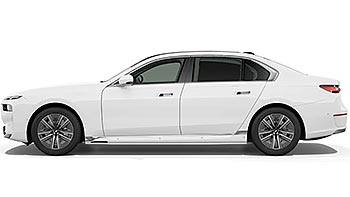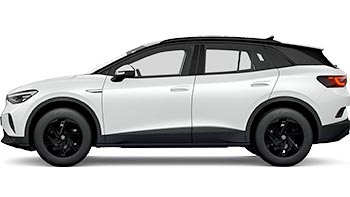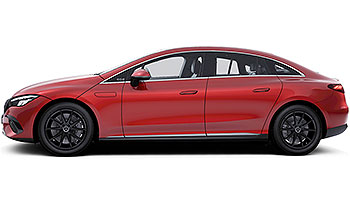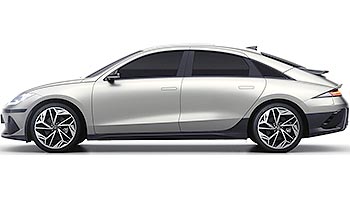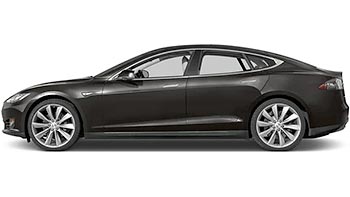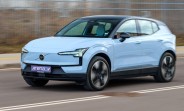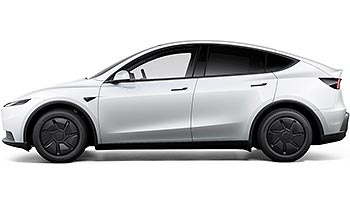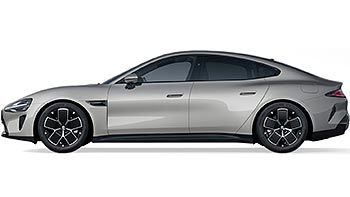Hyundai Ioniq 5 N review
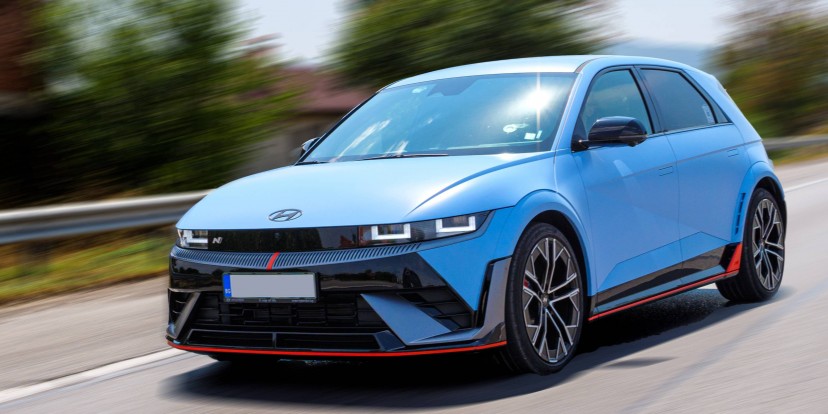
Hyundai has been rapidly increasing its performance "N" brand in recent years by competing in multiple rally championships and offering highly-potent turbocharged engines for its ICE-powered models. And with the electric Ioniq lineup doing so well in the market it was only a matter of time before the Koreans release a high-performance EV. Hyundai Ioniq 5 N came on the back of a lengthy teaser campaign and it was one of the most anticipated launches in the industry lately.

Table of Contents:
- Exterior
- Interior
- Storage & practicalities
- Driving experience
- Tech features
- Ride comfort
- Cabin noise
- Acceleration and braking
- Consumption
- Charging speed
- Competition
- Verdict
We finally got our hands on a production model, so we could check if it was worth the hype. It is a pioneer in the electric world in many categories, but its main focus is on delivering a truly exciting electric car - one that goes beyond quiet city commutes and traffic light drag races. But how far did it go in delivering on that promise?

The test model we have today is the Hyundai Ioniq 5 N, finished in matte Performance blue and outputting the imposing 650 hp and 568 lb-ft. That power is delivered to the road via all four wheels through one motor on each axle that should also boost traction.
- Dimensions: 185.6 inches x 76.4 inches x 62.4 inches, 118 inches wheelbase.
- Drivetrain tested: N - AWD 478 kW (650 hp), 568 lb-ft, 84 kWh total battery capacity, 80 kWh usable battery capacity
- Charging: 240 kW CCS; 230V V2L
- Range: 278 miles WLTP
- Weight: 5,082 lb unladen
- Other features: Engine sounds, Simulated gears, Performance displays, OTA updates.
Exterior
The core design of the Ioniq 5 N is identical to the regular model, but we have a bunch of aggressive elements sprinkled on top. The N version adds a bunch of air vents around the exterior, as well as a bigger rear spoiler and more pronounced side skirts for an overall lower and meaner look.

The front bumper of the Ioniq 5 N is almost completedly black, no matter the exterior color, which adds to the aggressive styling and further distinguishes it from the standard models. There are multiple cuts and vents in the front, to improve the downforce and help cool the brakes and batteries.

The side profile of the Ioniq 5 N isn’t changed much from the regular model, but there’s a noticeable difference in the clearance between the two. The 5 N sits lower to the ground due to its lowered suspension, but also because of its larger side skirts.

One thing that makes the N unique are the flared fenders. A wider body makes a car look more aggressive, but the Ioniq 5 N also has a wider track so it needs the extra arches to accommodate the tires.

Red accents all around further underline the sporty character of the Ioniq 5 N, and make its primary color stand out even more. The Ioniq 5 N comes in a choice of 7 colors, which somewhat limits personalization options, but chances are you won't see too many of those on the road anyway.

The Hyundai Ioniq 5 N doesn't get the polarizing camera wing-mirrors of the conventional model, going for the more traditional look.

Hyundai only offers one set of wheels for the Ioniq 5 N - 21-inch multispoke alloy ones, which suit the design and fit the aesthetic of a sporty vehicle. The tires that come as standard are the Pirelli P Zero, which understandably prioritize grip over low rolling resistance.
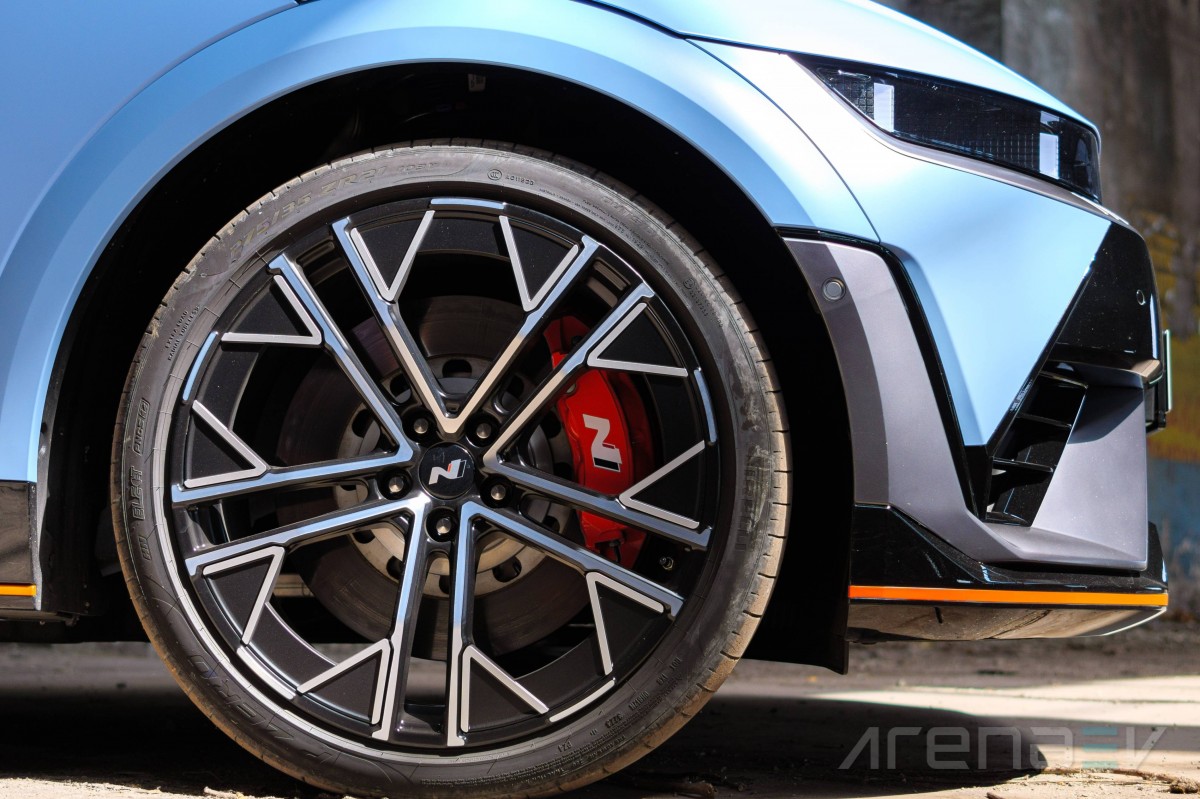
The rear end of the Ioniq 5 N is more beefed-up and squatted compared to the regular model. This is thanks to the dual rear spoiler, lower stance and meaner diffuser, all of which add up for a hot-hatch-like presence on the road.

Interior
Inside the Hyundai Ioniq 5 N we notice a bunch of differences, even if the overall feel didn't change significantly. Sadly, there are still some cheap plastics in key places and some surfaces are not as ergonomic as they could be, but the overall impression is of a very solid interior with little to no rattle sounds.

The first thing you notice as you open the vehicle are the bucket seats, which replace the cushy front seats of the regular Ioniq 5. They are finished off in leather and alcantara and offer fantastic side support, without being uncomfortable for longer journeys.

The steering wheel has been updated to accomodate more functionalities. There are controls for the entertainment and cruise control as before, but the performance buttons are exclusive to the N version.

The blue button at the top left lets you select the drive mode, so that you can quickly change between normal, eco and sport.

The top right hides a more impressive feature, labeled "NGB." That stands for N Grin Boost, giving you an extra surge of power for 10 seconds when you press it. This unlocks the full power of the vehicle and lets you overtake with even greater confidence.
The lower part of the steering wheel features 2 "N" buttons - one on each side. By pressing them you engage predefined settings, which you set in the multimedia to correspond to each button. This way you can have your favorite sport setting on one button and relaxed mode on the other and easily switch between the two, instead of going through multiple menus to achieve it.

Behind the steering wheel we see the Ioniq 5 N's biggest party trick - the paddle shifters for the simulated gear changes. When driving in normal mode, they control the recuperation levels like in many other electric vehicles. The caveat is that the 5 N offers simulated engine sounds that even allow for artificial gear changes, which no other EV on the market offers as of now.

The gauge cluster is the same as in the normal Ioniq 5, but here it can also act as a tachometer and show you the RPMs you’re driving at. This is also true for the heads-up display, which is the same unit as the regular Ioniq 5, but with an added rev counter.

The 12.3" center display is mounted on the same surface as the driver's screen and is identical to what you'd find on the normal Ioniq 5 offers. It has great visibility even in very sunny weather and there is almost no lag when operating it.

The control panel for the climate controls remains unchanged as well, which is a good thing as it works perfectly well. It would've been nice if the start/stop button was touched up for a more sporty feel, as it now blends too much with the rest of the buttons, but we are just nitpicking here.

The console between the front seats used to be a movable unit that could provide more space up front or in the back of the Ioniq 5. In contrast the N has a stationary island that provides three USB-C charge ports, one cigarette lighter and a wireless charging pad. All of that is accompanied by big pockets, where you can store a lot of small frequently used items.


The center console no longer moves forwards and backwards.
There is also a spot for bigger items like a backpack or groceries right between the seats, as well as some small storage in the armrest.

Instead of a regular rear-view mirror, the Ioniq 5 N comes with a camera-mirror. It is arguably a good decision as the C-pillars are massive and limit the rear window visibility, but the camera tricks you into thinking that vehicles are much closer than they are, which may be problematic in some situations.

The door panels are unchanged compared to the standard Ioniq 5, save for some added racing stripes. Sadly the surfaces on the doors don't feel particularly nice to the touch. The materials are rough and feel cheap, which isn't exactly what you wish to find in a vehicle at that price point.
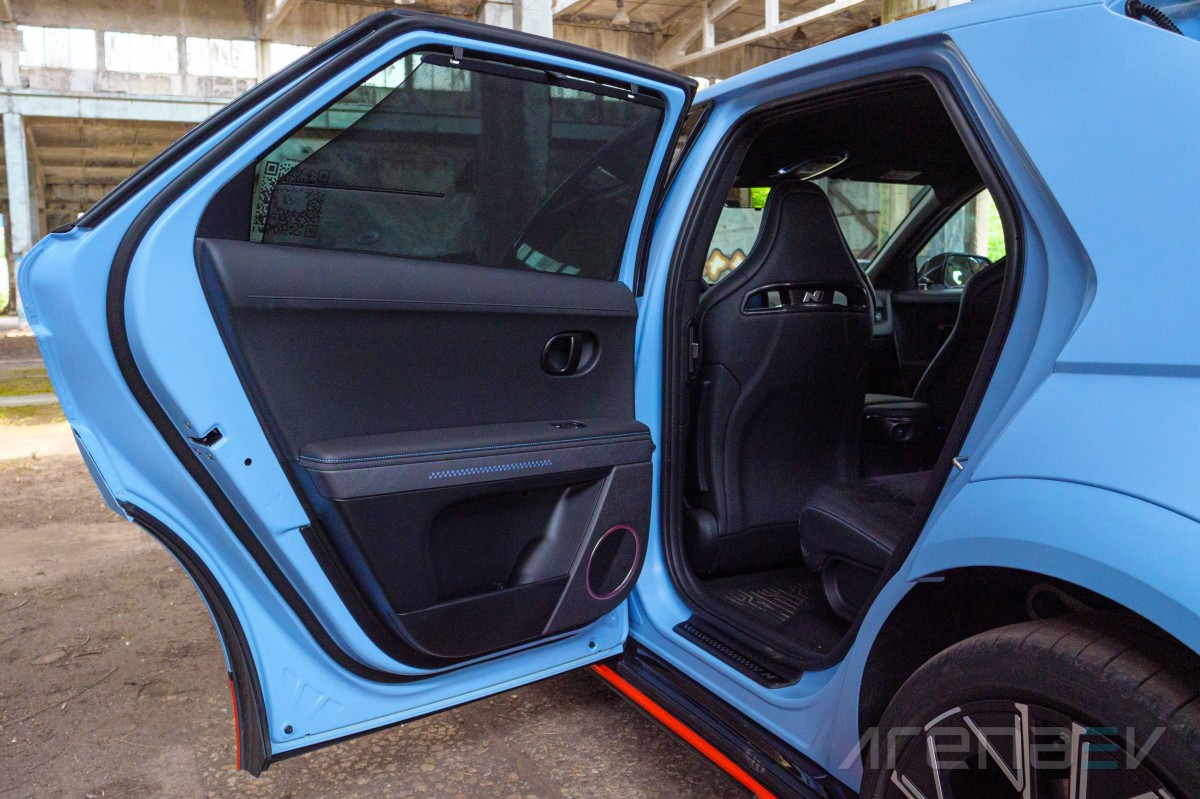
The back of the Ioniq 5 N offers plenty of legroom and headroom. The narrow seatbacks of the front bucket seats free up a lot of space for the rear passengers, even more so than in the regular Ioniq 5. Our reviewer is 1.95 m (6'4") tall and sits comfortably, although the seating position is quite low, causing some inconvenience even for shorter passengers.


The rear seats offer generous space even for tall adults.
There are some neat amenities like rear blinds, heated seats, full sized power outlet and climate vents. The rear seats can go back further into the trunk to allow for better relaxation or sleep for the passengers.

Storage & practicalities
The Ioniq 5 N is not particularly impressive when it comes to trunk capacity. The regular Ioniq 5's cargo space was already less than perfect as the designers prioritized cabin space instead. The N gets an even smaller trunk capacity of 17 ft³, and while that number isn't terrible, its usability is highly limited thanks to the irregular shape.

It’s good that there is some storage space beneath the main floor, allowing you to store smaller items you don’t need all the time. Thankfully, with the seats folded down the Ioniq 5 N offers the respectable 54.4 ft³ of loading volume.


By folding the seats the trunk becomes much more practical.
Another practicality downside compared to the regular Ioniq 5 is the lack of a frunk (front trunk).

Driving experience
Hyundai wants to reimagine the "hot hatch" segment with a larger but more powerful car, which retains all of the sporty driving characteristics. The proportions of the Ioniq 5 N are reminiscent of a hatchback, but what makes hot hatches so desirable is their nimbleness. We were rather skeptical that the Ioniq 5 N would deliver that, yet Hyundai tackles that challenge masterfully.
Let's start with the 5 N's most exotic feature - the presence of a "gearbox." It is activated as an individual mode and isn't on unless you want it to be. Combined with the fake engine noises pumped in through the speakers, the experience should mimic an ICE-powered car. We really can't say it's a very convincing impression as you can immediately tell there isn't a petrol engine under the hood, but the experience is fun and engaging.

The way the "gears" work is that the electric motor stops powering the wheels once it reaches a certain RPM and speed readout. Then you need to upshift in order to go faster. You feel a cool push just like in a vehicle with a dual-clutch gearbox and that sensation feels quite close to the real thing. What gives it away is that power is straightline, just like in all electric vehicles, instead of gradually building like in a petrol engine. Power just cuts off once you reach a certain speed and the sound at the red line is rather far from a real engine.
Leaving the gimmicks aside, we can happily report that the Ioniq 5 N stands out as more fun and engaging than virtually all other EVs on the market. The entire experience behind the wheel is happy and youthful and we mean that in the best way possible!
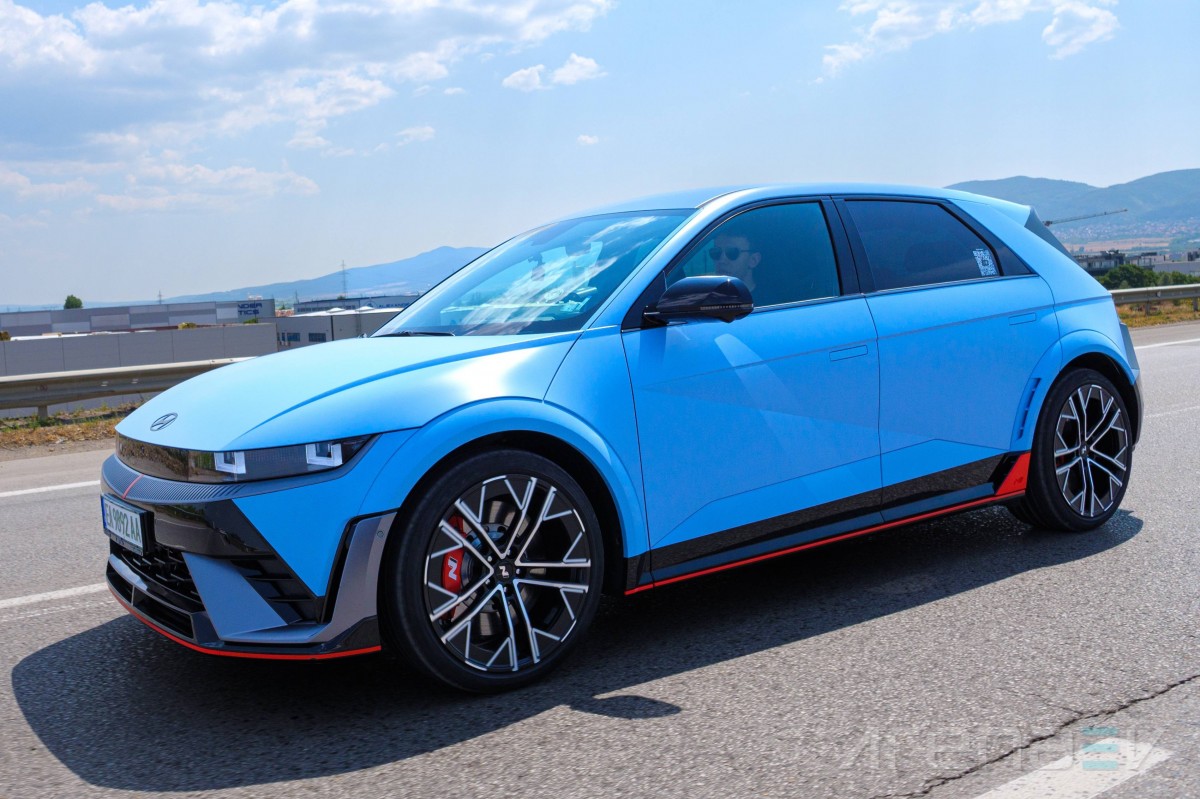
Power is never lacking, but what's arguably even more important is you the excellent bracking performance, which gives you the confidence to push closer to the car's limit. The hot hatch feeling is definately there.
At twice the body weight, this puts a lot of stress on all components like tires, brakes and suspension, but as long as the vehicle is maintained properly and everything is changed regularly, it is a blast to drive around and have fun in.

N drift optimizer allows you to enjoy full-fat drifts on a racetrack if the circumstances allow for it. When in drift mode, all power goes to the rear wheels and the computer balances how much of it each wheel gets to help keep optimal drift angle. It is a really fun way to spend an afternoon, but be prepared for a massive bill as the 21-inch Pirelli P Zero's are not exactly budget tires.

But let's say you don't want to be a boy racer all the time and just want to cruise around and enjoy the ride. The Hyundai Ioniq 5 N handles that equally well. We already thoroughly reviewed the regular Ioniq 5 and we are pleased to report that in comfort mode the two vehicles don't differ much. The N has adaptive dampers, which stiffen up in sport mode, but allow for more suspension travel in comfort mode, allowing you to effortlessly use the Ioniq 5 N as a daily driver without sacrificing the ride comfort.
The steering wheel feedback also differs vastly across the different drive modes, giving you the opportunity to maneuver easily with one hand on your trips to work, but deliver accurate inputs when going around a track on the weekends. The road feedback you get through the wheel is more than impressive for a crossover and you always know how much grip you have. However at higher speeds it's getting a little vague and and you end up being unsure whether the car will under or oversteer, which might be a problem for track enthusiasts.

As usual for the brand, Hyundai has equipped the Ioniq 5 N with all kinds of safety systems and driver aids. Sadly, not all of them can be turned off permanently and require you to manually switch them off every time you start your car. It is an annoying process, but such is the European legislation and manufacturers have to abide by it. If you want to know the details - here is our thorough explanation.
Tech features
The Hyundai Ioniq 5 N shares all of its displays with the regular Ioniq 5, so it's no surprise they work in similar fashion and provide almost the same functions. The key difference, is that the 5 N offers specialized sport screens that provide you with information and settings for precise adjustments of the vehicle at all times.
First off, you’re offered the ability to select the modes that the "N" buttons on the steering wheel will toggle. There you see all possible adjustments in the same place and can set them to your liking in each mode. Notably, you can control the engine response, the suspension, the steering, how the electronic diff responds, how invasive the ESC system is and even what the head-up display looks like.

One setting that stands out is the NAS+, which essentially changes the fake engine sounds. There are three options, none of which sounds really convincing, but are fun nonetheless. "Ignition" comes the closest to a modern petrol engine, while "evolution" and "supersonic" are what a car from the future in an 80's sci-fi movies sound like.

Since the 5 N is so performance oriented, it comes with an in-car lap timer that comes with a multitude of built-in tracks that you can conquer and possibly see how your Ioniq 5 N stacks up against the competition.

There are also the gimmicks from the regular Ioniq 5 that allow you to check the weather forecast or see sports results and upcoming fixtures. You can also set your favorite teams and get notified whenever they play.


You can check the weather or current sport events in the Ioniq 5 N.
The menu for the driving assistants appears convenient at first, but it's a bit too complicated. You have to press the exact part of the vehicle you wish to configure and then select from a list of submenus before actually changing the settings you want.

The navigation system is borrowed directly from the Ioniq 5 and works well, giving you charging stations along the route if you need to use them to reach your final destination.

The presence of a V2L port is super convinient and we're glad it got carried over to the N version. This function allows you to use the Ioniq 5 N as a power source and connect household-style plugs and enjoy your appliances everywhere you go.

Ride comfort
As we already mentioned, the ride quality of the Ioniq 5 N is very good for daily driving and offers sufficient comfort levels. Of course, it is no luxury limousine and is far from the best in that category, but for a 650 hp rocket one couldn't realistically ask for more. The suspension feels crashy with smaller potholes, which you tackle at speed but bigger obstacles, where you aren't driving as fast don't cause much shaking inside the cabin.
Cabin noise
The Hyundai Ioniq 5 N is well insulated from the outside world and doesn't let many ambient noises inside. What is mostly perceived inside are tire and wind noises, which are slightly more noticeable compared to the regular Ioniq 5 due to the added vents and spoilers.
Sound level tests are carried out with a specialized sound level meter placed in the car's cupholders. The test is conducted with air conditioning and radio off and while maintaining a steady speed.
Acceleration and braking
You probably won't be surprised to hear that the Ioniq 5 N is very rapid off the line. Still, its acceleration values are even more impressive than what the manufacturer states and according to our test the Ioniq 5 N goes from 0 to 62 mph in just 3.36 seconds, instead of the 3.5s Hyundai promises. The 62 mph to 124 mph acceleration takes exactly 10 seconds, which isn't a bad result, but given how powerful the N is we would've expected a better one.
The braking performance of the Ioniq 5 N is equally impressive. Going from 62 mph to a halt requires only 32 m (105 feet), which is impressive and a benchmark all manufacturers should strive to match. With the increasingly more powerful new models that go out on sale each year, we often complain how their braking isn't good enough for the acceleration figures, but in the case of the Ioniq 5 N we are glad to announce that it brakes perfectly and is able to match its results multiple times without worsening.
Acceleration and deceleration are measured with a RaceBox device inside the car. Testing is done with a single person inside the car, with air conditioning and traction control off.
Consumption
The Ioniq 5 N is not the most efficient vehicle around, but thanks to its bigger battery, the N version offers almost the same range as its AWD regular version with half the power. For our detailed test of the Ioniq 5 N's range, check out the dedicated article.
We measure consumption by driving at constant speeds on an identical test route during the day. Testing is conducted with air conditioning, all safety systems and radio on. The data comes from the vehicle's board computer. Specific testing parameters such as ambient temperature are mentioned in the text on a case by case basis.
We now suggest you use the widget below to find out the Hyundai Ioniq 5 N's range in every combination of speed and temperature you might need. We've used our real world tests and a complex physics model to provide an estimate that should be as close to the actual performance as possible.
Charging speed
The Ioniq 5 N is a quick-charging vehicle supporting up to 240 kW input, which allows for a 10-80% charge in only 18 minutes. We managed to confirm that number in our charging test. The 5 N benefits a lot from that, as you can go on longer trips and not worry about its limited range and just charge more frequently.
One thing that the Ioniq 5 N offers and not many of its powerful rivals have is V2L both inside and outside the vehicle. That means you can safely visit a jobsite or camp at a remote location and power all kinds of electrical appliances you might need, in case there is no electricity available.

Competition
There is almost no true competition for the Hyundai Ioniq 5 N, as its set of features turns it into somewhat of a unicorn in the EV world. The drift mode, artificial gears and engine sounds differentiate it substantially, while its extravagant looks and aggressive styling make it stand out in traffic.
The most relevant alternative to the Ioniq 5 N is then perhaps the Tesla Model Y Performance. It has been on the market for some time and has become a common sight, but it is really starting to feel long in the tooth. Still the Model Y offers the same acceleration figures (on paper at least) and much more storage space. However, the driving experience in the Hyundai is much more engaging and you can have substantially more fun behind its wheel.
The second rival actually comes from the same family, shares a platform with the Ioniq 5 and is the Kia EV6 GT. It first premiered in 2021 and offers less power, but due to its lower weight the acceleration stats are the same as the 5 N. The EV6 looks more traditional and once again doesn’t offer that drama of the engine sounds, DCT transmission and drift mode. The Kia is much cheaper, despite offering most of what the 5 N does, but it's not quite up there when it comes to driving fun.


Tesla Model Y Performance 2019 - • Kia EV6 GT 2021 -
Verdict
Over the years, electric vehicles have gotten a lot of hate for being soulless and sterile compared to ICE cars and for a lot of them this is actually true. The Hyundai Ioniq 5 N bridges the gap, showing that it can be done. It may help attract true petrolheads to electric vehicles as we finally have a mass-produced electric model that focuses on fun, rather than outright performance, although it does great in that category as well.

The Hyundai Ioniq 5 N is a thus akin to a teenager's idea of what a cool car for grown-ups should be. It has a lot of that hot hatch spirity, while being vastly more practical. Naturally, the fake sounds and gears may rub many the wrong way, while the car as a whole may benefit from better interior materials, but the overall sensation of there's no denying it's a fine product that won't disappoint its future buyers.

Thus, the hype that greeted the 5 N was well justified and we can only hope it will motivate more manufacturers to develop more engaging and fun to drive EVs. The Ioniq 5 N is definitely one of those cars we'll think back to in a few years as the pioneer of an entire new segment.
Pros
- Great handling and sufficient road feedback.
- Well-performing on-board technology.
- Spacious interior.
- Amazing brakes.
- V2L charging both in and outside the vehicle.
- Different infotainment layouts depending on the mode.
- Easy to drive, without being too overassisted.
Cons
- Simulated gear shifting experience.
- Synthetic engine sounds.
- Not many personalization options for the exterior and interior.
- Some internal surfaces feel rough and cheap to the touch.
- High price.
- Unimpressive trunk and no frunk.
Related
Reader comments
- DrexJB
How much is this machine
- 02 Dec 2025
- guw
- Anonymous
Actual range test results seem fishy.
- 12 Jul 2025
- kmq
- SpaceQ
Was racing with one on German highway ... impressive , acceleration power however didnt seem to be linear ..me with lucid
- 04 Jun 2025
- mEu





